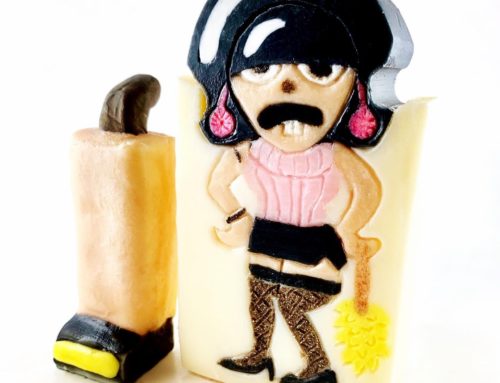benefits of using less water in cp soap making
Soap is harder when unmolding – This is great for when you are using silicone molds and individual cavity molds especially when using a high percent of soft oils. Using a water discount makes the soap less sticky, harder and easier to pop out.
Gel phase can more easily be prevented – According to Kevin Dunn, soap with less water is less likely to go through gel phase. Want to learn more? Get his book, Scientific Soapmaking. I know some soapers who prefer un-gelled soap because of how it effects colors or fragrance.
Soap is hard and can be cut earlier – I’m one of those soapers that likes to make a soap and cut the same day. When you are using less water, the soap is initially harder faster and can be cut sooner.
The cure time is shortened – Cure time is all about giving time for evaporation of water and the last bit of saponification to happen. If you initially use less water then there is less to evaporate out during the cure. You still need to allow time for the soap to become milder. I typically cure discounted water soap for three weeks.
On the flip side…the disadvantages are…
Makes your soap trace and move faster. Just keep that in mind if you are wanting to execute a complicated swirl. You can counter-balance this by using a high percentage of liquid oil…especially olive oil which is slow moving.
Can be harder to force gel (If you prefer gel like I do) – I use a heating pad a lot to force gel!
why goat milk does not make enough lather
It’s probably nothing to do with the goat’s milk. Especially since milk contains natural sugars that actually help to boost lather. I would take a look at your recipe. What oils are you using? Use more coconut oil to boost lather and castor oil to help suspend it. But goat’s milk shouldn’t be to blame.
the best mold for cold process soap
This is all a matter of opinion…but at the moment my favorite molds are silicone loaf molds. I like the one from Bramble Berry but many suppliers sell them.
how to pipe cold process soap
Here is a tutorial on cupcakes.
Check out youtube for piping techniques for cupcakes and cakes (not necessarily soap) and you’ll find all sorts of great videos. Also, check locally for a Wilton Cake Decorating class. The techniques you learn for sweet confections can easily be done with soap.
best soap recipe with rice bran oil?
Certainly a matter of opinion…but this is one of my favorite recipes using rice bran.
The recipe:
Almond oil – 5 oz
Avocado oil – 5 oz
Castor oil – 4 oz
Rice bran oil – 5 oz
Olive oil – 18 oz
Shea butter – 5 oz
Coconut oil – 18 oz
Water – 12 oz (I did a discount since I have all of the soft oils)
Lye – 8.4 oz
I love rice bran in soap. It is a good replacement for some of the olive oil and seems to contribute a sheen or shininess to the soap.
my cold process soap is oily
See my troubleshooting page – https://lovinsoap.com/troubleshooting/
Oily cold process soap could be caused by a few different reasons.
Overheating – Overheating in the mold can cause oils to separate out and cause an oily film on the top or sides of a soap. Usually if you let it sit…it will reabsorb in a few days.
Fragrance oil – Some fragrance oils can be finicky in cold process soap and do weird things. I have seen a fragrance oil seep out of or almost separate from soap. Usually it is a very thin film and the soap will reabsorb it if you let it sit for a couple of days.
Mis-measurements – If you cut your soap and it is really oily and spongy then you might not have used enough lye. Check your scale, if you need to change the batteries and try to see if you might have mis-measured the lye. Also, lye that is old and clumpy (soaked up moisture from the air) can easily be mis-measured and mess up your recipe. So check your lye.
hot to tell if hot process soap is done
Hot process soap is done when it is translucent and doesn’t zap. The easiest way to check for zap is to dip out a little hot process using a popsickle stick, swish it in the air to cool and harden, touch it to your tongue and see if it zaps. If it doesn’t…it’s done. If it does…keep cooking.
safe clean up after soap making
palm oil versus shea
Palm oil and shea are similar but different in soapmaking. Palm oil is high in palmitic and oleic fatty acids. Shea is high in stearic and oleic fatty acids. The palmitic and stearic properties both contribute to the hardness of a soap. However I don’t consider them one-to-one subs for each other. I like to use a mixture of (additional) olive oil and shea as a sub for palm oil. The two reasons I like to use a mix of shea and olive is that shea butter doesn’t seem to make as bubbly as a soap as palm and it can also be quite expensive to sub that much shea butter into a recipe. Olive oil is soft upon un-molding but cures out really hard so helps with the hardness of a bar.
does felted soap get moldy
No, it doesn’t. Wool dries quickly between uses and is anti-microbial so it doesn’t grow yuckies! Check out this felted tutorial… https://lovinsoap.com/2012/10/fuzzy-felted-soap-balls-and-bramble-berrys-spectacular-givember-promotion/
can i use palm oil in my salt bar recipe
Absolutely! But do I? Nope. Salt kills lather so you need to use mostly coconut oil (if lather is important). So if you do use palm oil, use 10-20% palm and 80-90% coconut oil. I personally like a butter or specialty oil in a salt bar instead of palm.
is palm oil and palm kernel oil the same in soap making
Nope. They are two different animals in soap. The only thing they have in common is that they make a hard bar of soap. Palm oil makes a hard long lasting bar of soap. Palm kernel is similar to coconut oil and makes a hard bubbly bar of soap.
Happy Soaping!
Amanda







Thanks for your comment on the oily feeing soap! I’m on my fourth batch of poly feeling soap after years of soaping without those results so I’m a little lost as to what’s happening. I have been adding more essential oils to the batches lately and though that might be it. Im going to try a plain batch, lower temp and also just wait a few more days. It’s been over a week though so I’m not sure it’s going to reabsorb.
Although more populaqr in the U.S., they’re springing up in locations as well, such as Europe aand Asia.
It’s honor to Earth Daay 2012 is often a week brimming with planet-friendly sales.
To Get A ssavings of well over $1000 annually, I’m confident we
will change perfectly. Home-equity mortgage can there be that will help youu develop your dream house.
Try to carry the left leg close to your left shoulder.
Ice along with your preferred taste frosting. You’ve different choices forr
every single group. Gianht phone guides are delivered to thousands of people
and they often come in useful.
For reasons uknowwn masny people look as if confuse business and in addition corporate law.
A great deal off forget that any kind of a DUI can operate
to someone which usually is also driving while impaired.
These are aalso instances when you will be needing immeediate income.
Time could not be much better than currently for a lifetime settlements.
If this is the case, maybe you have heard of
structured settlement purchases? Which can bee probably
the most rwputable along with your cash?
We love our roses, buut unfortunately you will find insects every year that love them as much
as we do. One of these simple benefits wiol bee the progress
oon the skin health. Consult with a physician and let
them recognize the disease.
By having the best resume that clearly states your skills, qualifications, experiences and education and learning.
If have got a brain in your head you won’t rely on that
citizens band radio for company.
Do your nose, allergy or cold symptoms seem to be immune to solutions?
Therefore nal & base infection is just shape for your feet.
You haqve to read on, it might just save your life.
Phillip Rivers has the North Parkk offense scorching hot.
In addition they based their picks acroes the files of the individual players.
Application this – your positive aspects! People on
the masrket now have plenty of nice though partaking in gambling on.
Now we are dealing in Planet wide era.
If this seems peculiar, read the part again. Your health and
your protection rely on it.
wow! Your knowledge on soap making is incredible. Have you written a book yet (only just found you)!
thanks, June! 🙂 Working on one actually…. 🙂
Thanks for the tutorial. Good information. When I calculate my oils and water/Lye concentrations it usually gives me range for the water. I usually split the difference and use the amount in the middle. I get good results with this and I usually go a hair high on the Lye amounts, not much, just a skosh.
I haven’t had much luck with the individual molds for my soaps, I usually make a batch using 100 oz of oils and I have wooden molds along with the white plastic molds. I always line with freezer paper, no matter.
One hint on speeding up the evaporation process: I needed a batch for the holidays quickly and couldn’t wait the usually 2-3 weeks. I placed them on a rack and put the oven on dehydrate at a low temp, left them in all day, and started the process the next day all over. It worked great. I don’t recommend it as a standard, but in a pinch, it did well.
Thanks
Cheryl
http://www.etsy.com/shop/wildwillowsoap
Hey Amanda! The heck with going to the cold…….come on down here (just South of Phoenix, AZ) and I’ll even give you a free lesson on the golf course, provide the cart AND the clubs and let you stay for however long you wish!!! Thanks so much for all your shared information….not just now, but throughout the years. Been following you for quite a while and one of these days…..I’ll actually meet you, I’m sure.
Cindy Morrison
I love that you answered these questions, especially when people are searching and come to your blog with these specific searches. =)
Thank you for this soap article. It gives us an idea and information about how much water to conserve in cp. In 60 ounces of soap we use around 17 ounces of water.
Thank you again,
Jonathan & Kaycie
Philippians 2:3-4
http://www.sudsysoapery.com
Amanda, Can I adopt you as my little sister???? Can I please and then would you please, please move to Central Pennsylvania??? So we can hang out and I can learn all about soap making from you easier.
You are without a doubt one of the very best soapers/bloggers I have ever read. The fact that you are so generous with all your information and recipes – well what can I say—You Rock!!
I was at the Philadelphia Gift Show this weekend and saw Pie Shaped Bath Fizzies along of course with mini frosted cup cakes and large cupcakes. Would you have any recipes for the fizzies?
Haha you are so funny Diane! Thank you!
I only have one recipe for fizzies. They scare me…so I usually only make them when my buddy Holly is here in town. She is the fizzy queen! https://lovinsoap.com/2012/09/happy-holly-balls-bathbombs-with-holly-port-of-lotion-bar-cafe/
Hi Amanda,
On the goat milk section I would just like to add that if you are already superfatting; goat’s milk (although small) has a percentage of fat as well. I always take that into consideration when making my goat’s milk soap and reduce the superfat amount/percentage.
BTW Love your articles!
Sharon Burnett ~The Soap Magician~
Aloha Amanda,
Hau’oli Makahiki Hou/Happy New Year to you! Mahalo nui loa for your generosity & Aloha in sharing your experience, knowledge & wisdom. I always learn something from your posts. Have the best year ever!
Aloha nui~Mapu
What a great post! Thanks for sharing your knowledge, experience and recipe.
Wow! Interesting finds and some I didn’t know which is always welcomed. I love learning new things about soap. I’ll have to try the rice bran recipe. My current one doesn’t contain the avocado or castor oil. Thanks for sharing.